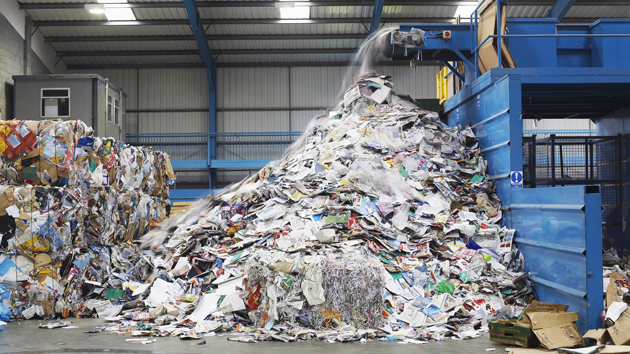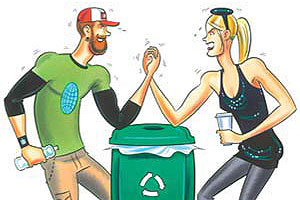
<a href="http://www.shutterstock.com/pic-146583215/stock-photo-waste-falling-on-pile-from-conveyor-belt-at-recycling-factory.html?src=q7WX2kHoFq8FFKYXvgI-Fw-1-26">bikeriderlondon</a>/Shutterstock
America’s recycling system is in crisis.
That’s the picture the Washington Post recently painted in a damning story on the state of recycling in the United States. First, the mixed-material “blue bins,” designed to decrease the hassle of sorting, are contaminating the recycling coming into facilities—meaning recyclable materials end up getting chucked into landfills along with trash. Second, thanks to lighter packaging, dwindling demand for newsprint, and low oil prices, the commodity prices for recyclables have decreased—so China, which used to buy most of our recycled materials, no longer has incentive to do so. According to the Post, this means that recycling is no longer profitable for waste management companies, and municipalities are stretching to pick up the cost.
So is the end of recycling drawing nigh? Not necessarily. The experts that I spoke to agreed that our system is broken—but for a slightly different set of reasons than those that the Post listed. And guess what? They think there’s a way to fix it. Let’s take a closer look at some of the common myths about recycling:
- Myth #1: Recycling was invented to reduce waste. Back in the 1970s, says Samantha MacBride, a sociologist at CUNY’s Baruch School of Public Affairs and author of the book Recycling Reconsidered, cities and towns became overwhelmed by the amount of plastic packaging entering the waste stream and started demanding something be done about it. In order to avoid regulation and the banning of plastic products they used, the beverage and packaging industry pushed municipal recycling programs. Decades later, the plastics used for packaging have barely been regulated—so cities and towns have to deal with more waste than ever before.
The problem is so overwhelming that many contract with private trash companies, the largest of which is publicly-traded Waste Management, which brought in nearly $14 billion last year. Recycling only generates a fraction of the revenue of these companies (much more comes from landfill, which requires less labor), but they are able to make some profit from selling bales of recycled materials to countries like China as raw material. When commodity prices are low, they shut down recycling plants and put recyclable materials in landfills, or renegotiate contracts with cities to charge more for their services. In short, these corporations have no incentive to reduce waste.
- Myth #2: Blue bins are what’s mucking up the recycling stream. In single stream recycling—the “blue bin” model—consumers put all their recyclables in one bin, while in dual stream, the consumer sorts the materials at the curb into different bins. According to Container Recycling Institute president Susan Collins, data does suggest that single stream recycling leads to more contamination than dual stream—garbage gets thrown into blue bins at a higher rate, spoiling what’s actually recyclable.
But MacBride says that contamination rates in single-stream recycling are not actually that much higher than that in dual stream recycling—and that people who complain about blue bins are missing a much larger problem: Because the packaging and beverage industry has opposed banning even the most troublesome plastics, like polystyrene, there are now “thousands of different kinds of plastics,” says MacBride. In 2013, the US generated 14 million tons of container and packaging plastic. It takes so much work to sort through that mess that it’s nearly impossible to make a profit doing it—so companies like Waste Management send it to China. Plus, all of the different kinds of plastics used for packaging confuse consumers. (Can the soda cap be recycled or just the bottle? What about the bag inside the cereal box?)
- Myth #3: Falling commodity prices mean the end of recycling. Big, profit-driven trash companies like Waste Management argue that factors like low oil prices, less demand for newsprint, lighter-weight packaging, and contamination from single stream recycling have slashed commodity prices and made recycling untenable. “It isn’t profitable for us, and we have to react by shutting down plants,” Waste Management CEO David Steiner told the Wall Street Journal. But Collins says this is “not a surprise to anyone.” She and other recycling advocates point out that recycling markets fluctuate like any commodity; oil prices and the market will eventually adapt and rebound.
- Myth #4: The solution is to quit recycling—it’s just not worth it. That’s the story Big Waste has been peddling. But some smaller recycling outfits aren’t buying it. Take the city of St. Paul, Minnesota: Fifteen years ago, city officials balked when Waste Management raised its rates for the city’s curbside pickup program by 40 percent. So St. Paul ditched Waste Management and contracted with a new partner: a nonprofit called Eureka Recycling. Since 2001, Eureka reports, its recycling program has generated $3.5 million in revenue and 100 new jobs. It also diverts 50 percent of its trash away from the landfill, with a goal of 75 percent in the next 5 years*—an accomplishment it has achieved largely through a program that gives consumers clear instructions about what they can recycle.
Employee-owned Recology in San Francisco also educates residents about recycling and employs hundreds of people to sort the materials coming into their recycling facility. As a result, while Recology, which saves 92 percent of San Francisco’s trash from the landfill, isn’t seeing Wall-Street-level profits, it isn’t experiencing a crisis either. As Collins points out, when commodity prices are down, the the highest quality bales are sold first, rewarding operations doing the best job recycling.
One way to improve the bales: Ditch the plastics that are hardest to recycle. Indeed, a growing number of cities—including San Francisco—have banned plastic bags and polystyrene. The result is less sorting required at the facility—and better bales. As Recology manager Robert Reed told me, “We are confident that we can move our materials because of the high quality of the bales that we make and the quality of our recycling process.”
Correction: A previous version of this story misidentified the percentage of trash that Eureka Recycling diverts away from landfill.












